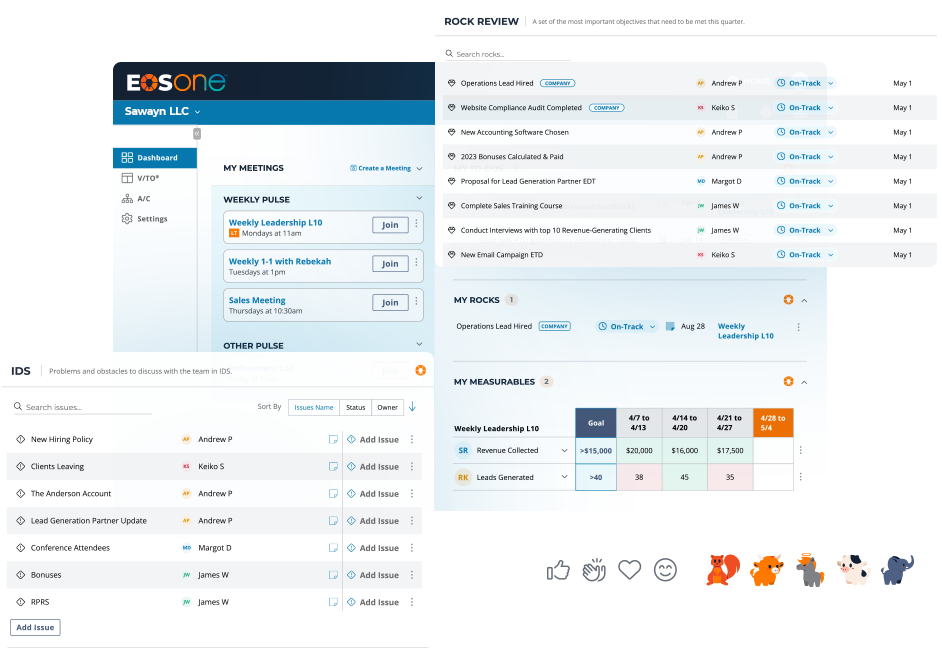Do you ever feel like your meetings don’t accomplish anything? And most of your time is spent discussing things with no real solution? We’ve all been there. An hour goes by, and suddenly you realize no real progress has been made.
It can be so frustrating. In today’s episode, we’re digging into the solution to your meetings, the EOS® IDS® tool. IDS stands for identify, discuss, and solve, and it is a powerful issue-solving tool within EOS that drives effective decision-making and fosters collaboration. It’s like a compass that guides teams toward clarity and alignment. Doing IDS well is like a pit crew in auto racing…
Every team member has a specific role, and they know their job really well. When the time comes, they swiftly identify any issues with the car, discuss potential solutions, and work as fast as possible together to solve them with precision and speed. Just like a pit crew aims for seamless teamwork and fast track times, using IDS effectively ensures that problems are identified, discussed, and solved efficiently for the long-term greater good of your organization, allowing you to maintain your competitive edge.
When you IDS effectively, your business grows. It’s a fact. Here are some of the benefits you’ll experience when you use this tool. You’ll have clarity. Using IDS well helps teams gain clarity by identifying the root cause of issues. It eliminates confusion and focuses discussions on the core problem, enabling teams to address it directly.
Alignment. By engaging in open discussions and considering different perspectives, IDS fosters alignment among team members. It also ensures that everyone understands the issue at hand and works together toward a shared solution.
Collaboration. IDS-ing also promotes collaboration and innovation. It creates an environment where everyone feels comfortable expressing their ideas and their opinions.
Effective decision-making. By thoroughly discussing the issue and evaluating various solutions, teams can make informed decisions to find the best possible solution.
Accountability. Using IDS establishes accountability within the team by defining specific action steps and responsibilities with a deadline. It ensures everyone knows what needs to be done and who is responsible for each task.
And the very last one I’d mention is results. Ultimately, using IDS well drives results. It helps teams overcome obstacles, make better decisions, and achieve their goals. OK, so here’s how you actually do it:
IDS occurs weekly during your EOS Level 10 Meeting™. You pull up your Issues List, which you’ve populated prior to the meeting, and you identify the top three issues that must be solved. I like to say that if you don’t want to discuss an issue, that needs to be number one. It should be something that is time-sensitive, is mission-critical, involves people or processes, or it could be some of your Rocks or your Scorecard numbers, but these are your biggest priorities and sometimes the most uncomfortable conversations.
Once your top three issues are chosen, it’s time to IDS. Identify is the “I.” So you start the IDS process by identifying the issue. If you can’t say what the issue is in one clean sentence, you’re probably not there yet.
Then discuss. Once the issue is identified, engage in open and honest discussion. Encourage diverse perspectives and active listening by leaving your egos at the door and focusing on finding the best possible solution for the greater good of the entire company.
Solve means that after you’ve discussed it and everyone’s voice has been heard, it’s time to brainstorm solutions. You have to evaluate your options objectively and choose the best course of action for the greater good of the company. Once the solution is decided, implement a clear plan with assigned accountabilities and timelines. These become your to-dos in your Level 10 Meeting.
Consensus is directly connected to how well you solve issues the first time they make it to your Issues List. You cannot take for granted that you have time. And we cannot work toward consensus. If we wait for consensus, we often will have missed a window of opportunity, and it could make you move so slowly that you actually harm the company. So throughout the IDS process, it’s essential to maintain focus and avoid getting sidetracked by unrelated topics or tangents.
You have to stay disciplined and stick to the identified issue at hand. It’s also helpful to remind your team that it’s just an issue, meaning there aren’t any really big or small ones. It’s anything that’s causing friction in your business. It could be something that slows you down, ticks you off, gets in the way – an obstacle, a barrier, an impurity, an idea, an opportunity…
That’s right. It can be the good stuff too. Issues are neutral. They aren’t bad things per se. They are things we have to talk about. And if you cannot solve it on your own, bring it to the Level 10 Meeting so we can help. That’s where teamwork comes in. If you can remember it’s just an issue, it will help alleviate emotional reactions by placing the focus on finding the solution.
Don’t worry if you don’t solve all your issues during your Level 10 Meeting. If you’re prioritizing and using IDS effectively, the most important ones should be solved weekly, and the rest can wait until next week’s Level 10 Meeting. On average, when teams get great at using IDS, they solve 5 to 10 issues every single week.
And when you think about the power of that, it should give you time back every week, because when you get together, you are laser-focused at removing that friction so that during the week you have fewer interruptions from one another. If it is not time-sensitive or mission-critical, you put it on the list, and it can wait till next week’s meeting.
If it is time-sensitive or mission-critical, you absolutely solve it in the moment. I see the power of using IDS every day with my EOS clients. I have one client who had 77 issues on the list at an annual. During that annual, I went home in the evening between day one and day two. As I was reviewing their Issues List, I zoomed out and I looked at the list in total, and I found that the vast majority of the issues – it turned out to be about 70 of them – actually had to do with operations.
When I walked into the meeting on day two, and we got to our IDS time, I asked a simple question, “How’s your operations leader doing?” Dead silence.You could have heard a pin drop. Our Integrator™ said, “Yeah, that’s an issue.” And I said, “Team, when we look at this list, the vast majority of the things on here have to do with operations. It’ll take you 10 years to solve those 70 issues if you take them one at a time. But if you look up and tell the truth, we have to have a tough people conversation right now.
As a result, we spent about an hour on that issue, working through what the plan would be. That employee still works at that company, though not in the same seat, because they were struggling. It was the wrong seat. Those 77 issues went down to 7 issues, and we solved every one of them at that annual session.
The IDS tool fosters collaboration, it encourages transparency, it ensures your decisions are made collectively. It also allows your team to tackle problems proactively and align solutions while they’re driving meaningful outcomes.
Begin using IDS today and watch your results improve.











